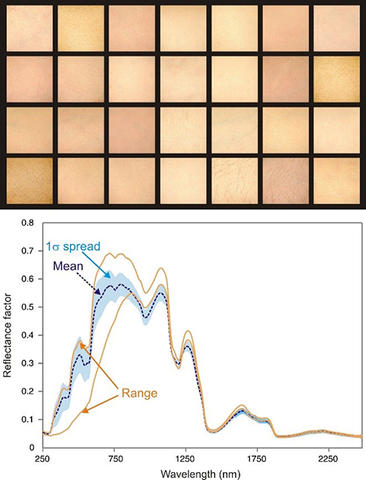Summary
The purpose of this human subjects study is to collect high-quality measurements of the reflectance spectrum of human skin and assess the variability across the population of subjects. The resulting data set will provide foundational measurements to support a variety of applications in which the optical properties of human skin is a component, such as automated or stand-off detection of hidden weapons and non-invasive diagnosis of skin diseases.
Description

Investigations of the optical properties of human skin have largely been limited to the visible part of the electromagnetic spectrum, whereas many applications require high-quality reflectance data in the near infrared and short-wave infrared. Further, the complex and dynamic nature of skin results in spectral reflectance that varies significantly, not only between individuals but within the same individual.
Questions of interest for this project include: Is there a "typical" signature for human skin reflectance? What is the range and distribution of spectral signatures across a population?
Measurements are made using a commercial spectrophotometer calibrated against white reflectance standards measured using the NIST Spectral Tri-function Automated Reference Reflectometer (STARR). Spectra are collected over a broad spectral range, from the ultraviolet to the shortwave infrared (250 nm to 2500 nm), to provide a data set useful for a wide variety of applications. The resulting reflectance spectra tie directly to the NIST scale of spectral reflectance as realized by STARR.
The analysis addresses instrument uncertainty, subject variability, and between-subject variability. Key contributors to the spectral structure of human skin include water, melanin, and hemoglobin. Future studies will be directed at expanding the set of measurements, including the incorporation of results from other researchers.
Photo caption: A sampling of images from subjects' test area (above). The reflectance spectrum of the mean of the set of spectra collected from 51 human subjects with blue shaded area representing the population variability for all subjects and the orange spectra representing the range of variation in reflectance factors observed (below).

